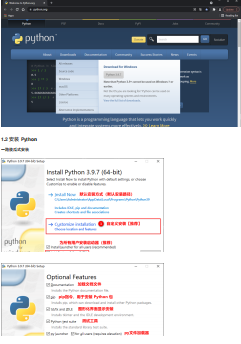我们帮大家精选了相关的编程文章,网友石涵易根据主题投稿了本篇教程内容,涉及到Python、os、sys模块使用、Python、os、sys模块、Python、os、sys、Python os sys模块相关内容,已被390网友关注,涉猎到的知识点内容可以在下方电子书获得。
Python os sys模块
一、os模块
os 模块是 Python中的一个内置模块,也是 Python中整理文件和目录最为常用的模块。
该模块提供了非常丰富的方法用来处理文件和目录。比如:显示当前目录下所有文件/删除某个文件/获取文件大小
1、获取当前的工作路径
在 Python 中,利用 os.getcwd() 函数可以取得当前工作路径的字符串,还可以利用 os.chdir() 改变它。
import os print(os.getcwd()) # D:\JQWS\PythonWS\demo1\dir6 os.chdir(r'D:\JQWS\PythonWS\demo1\dir2') print(os.getcwd()) # D:\JQWS\PythonWS\demo1\dir2
注意:如果使用 os.chdir() 修改的工作目录不存在,Python 解释器会报错。
2、os.path模块
2.1 获取目录名称和基本名称
获取一个路径的目录名称和基本名称的方法有:
- os.path.dirname():返回一个字符串,它包含 path 参数中最后一个斜杠之前的所有内容
- os.path.basename():返回一个文件名,它包含 path 参数中最后一个斜杠之后的所有内容
- os.path.split():返回一个元组,里面包含了一个路径的目录名称和基本名称。
- os.path.join():返回一个文件路径的字符串,包含正确的路径分隔符。
示例代码如下:
import os
path = r'D:\JQWS\PythonWS\demo1\dir6\a.txt'
print(os.path.dirname(path)) # D:\JQWS\PythonWS\demo1\dir6
print(os.path.basename(path)) # a.txt
# 路径切分
splitList = os.path.split(path)
print(splitList) # ('D:\\JQWS\\PythonWS\\demo1\\dir6', 'a.txt')
# 路径拼接
fPath = os.path.join(splitList[0], splitList[1])
print(fPath) # D:\JQWS\PythonWS\demo1\dir6\a.txt
2.2 判断是文件or文件夹
os.path 模块提供了以下函数用于检测给定的路径是否存在,以及它是文件还是文件夹:
- os.path.exists(path) : 判断 path 参数所指的文件或文件夹存在,
- os.path.isfile(path) :判断 path 参数存在,并且是一个文件,
- os.path.isdir(path) :判断 path 参数存在,并且是一个文件夹。
示例代码如下:
import os
path = r'D:\JQWS\PythonWS\demo1\dir6\a.txt'
# 判断是文件or文件夹
print(os.path.isfile(path)) # True
print(os.path.isdir(path)) # False
if os.path.exists(path):
if os.path.isdir(path):
print("是目录:%s" % path)
elif os.path.isfile(path):
print("是文件:%s" % path)
# 返回该文件的大小
size = os.path.getsize(path)
print("文件大小:%s" % size) # 80 字节
else:
print("啥也不是")

2.3 目录操作
import os
# 返回指定路径下文件列表(包含文件和目录)
file_dir = r'D:\JQWS\PythonWS\demo1\dir6'
list_dir = os.listdir(file_dir) # 若不指定路径,则返回当前路径下的文件和文件夹
print(list_dir) # ['a.txt', 'demo1.py', 'demo2.py', 'demo3.py', 'demo4.py']
# 创建文件夹
new_folder = "abc"
if not (os.path.exists(new_folder)):
os.mkdir(new_folder) # 创建一个新的文件夹
new_folders = r"D:\JQWS\PythonWS\demo1\dir6\test1\abc1"
if not (os.path.exists(new_folders)):
os.makedirs(new_folders) # 创建递归文件夹
# 删除文件夹
if os.path.exists(new_folder):
os.rmdir(new_folder)
if os.path.exists(new_folders):
os.rmdir(new_folders)
# 路径替换
print(os.path.relpath('D:\JQWS\PythonWS\demo1\dir6', 'D:\JQWS')) # PythonWS\demo1\dir6
print(os.path.relpath('D:\JQWS\PythonWS\demo1\dir6', 'D:\JQ')) # ..\JQWS\PythonWS\demo1\dir6
二、sys模块
sys 模块主要负责与 Python 解释器进行交互,该模块提供了一系列用于控制 Python 运行时环境的不同部分(函数和变量等)。
1、查看 sys模块
查看 sys 模块都包含哪些内容:
import sys d = dir(sys) print(d)
结果如下:
['__breakpointhook__', '__displayhook__', '__doc__', '__excepthook__', '__interactivehook__', '__loader__', '__name__', '__package__', '__spec__', '__stderr__', '__stdin__', '__stdout__', '__unraisablehook__', '_base_executable', '_clear_type_cache', '_current_exceptions', '_current_frames', '_debugmallocstats', '_enablelegacywindowsfsencoding', '_framework', '_getframe', '_getquickenedcount', '_git', '_home', '_stdlib_dir', '_vpath', '_xoptions', 'addaudithook', 'api_version', 'argv', 'audit', 'base_exec_prefix', 'base_prefix', 'breakpointhook', 'builtin_module_names', 'byteorder', 'call_tracing', 'copyright', 'displayhook', 'dllhandle', 'dont_write_bytecode', 'exc_info', 'excepthook', 'exception', 'exec_prefix', 'executable', 'exit', 'flags', 'float_info', 'float_repr_style', 'get_asyncgen_hooks', 'get_coroutine_origin_tracking_depth', 'get_int_max_str_digits', 'getallocatedblocks', 'getdefaultencoding', 'getfilesystemencodeerrors', 'getfilesystemencoding', 'getprofile', 'getrecursionlimit', 'getrefcount', 'getsizeof', 'getswitchinterval', 'gettrace', 'getwindowsversion', 'hash_info', 'hexversion', 'implementation', 'int_info', 'intern', 'is_finalizing', 'maxsize', 'maxunicode', 'meta_path', 'modules', 'orig_argv', 'path', 'path_hooks', 'path_importer_cache', 'platform', 'platlibdir', 'prefix', 'pycache_prefix', 'set_asyncgen_hooks', 'set_coroutine_origin_tracking_depth', 'set_int_max_str_digits', 'setprofile', 'setrecursionlimit', 'setswitchinterval', 'settrace', 'stderr', 'stdin', 'stdlib_module_names', 'stdout', 'thread_info', 'unraisablehook', 'version', 'version_info', 'warnoptions', 'winver']
2、获取参数列表
argv:返回传递给 Python 脚本的命令行参数列表。
import sys
if __name__ == '__main__':
args = sys.argv
print(args)
a = len(sys.argv) - 1 # 参数个数
print(f'参数个数:{a}')
# print(sys.argv[0]) # 当前程序名
# print(sys.argv[1]) # 第一个参数
# print(sys.argv[2]) # 第二个参数
# print(sys.argv[3]) # 第三个参数
3、退出当前程序
sys.exit(arg)——程序中间的退出,
- arg = 0:表示正常退出;
- arg != 0:表示异常退出,会引发一个SystemExit异常,从而可以在主程序中捕获该异常。
import sys
print('Hello--')
# sys.exit()
try:
sys.exit(3)
except SystemExit:
print("SystemExit异常")
print('end---')
4、标准输入输出
import sys
# 1. 标准输出stdout
# 下面两行代码等价
sys.stdout.write('标准输出stdout' + '\n')
print('标准输出print')
# 2. 标准输入stdin
s1 = input(">>")
print(s1)
s2 = sys.stdin.readline()
print(s2)
# 3.错误输出stderr
sys.stderr.write('错误输出stderr')
5、返回 Python 解释器所在路径。
import sys print(sys.version) print(sys.winver) print(sys.platform) print(sys.path) print(sys.maxsize) print(sys.maxunicode) print(sys.copyright) print(sys.modules) print(sys.byteorder) print(sys.executable)
sys模块其他方法:
- version:返回 Python 解释器的版本信息。
- winver:返回 Python 解释器主版号。
- platform:返回操作系统平台名称。
- path:返回模块的搜索路径列表。
- maxsize:返回支持的最大整数值。
- maxunicode:返回支持的最大 Unicode 值。
- copyright:返回 Python 版权信息。
- modules:以字典类型返回系统导入的模块。
- byteorder:返回本地字节规则的指示器。
- getdefaultencoding():返回当前默认字符串编码的名称。
- getrefcount(obj):返回对象的引用计数。
- getrecursionlimit():返回支持的递归深度。
- getsizeof(object[, default]):以字节为单位返回对象的大小。
- setswitchinterval(interval):设置线程切换的时间间隔。
- getswitchinterval():返回线程切换时间间隔。
到此这篇关于一文带你吃透Python中的os和sys模块的文章就介绍到这了,更多相关Python os sys模块内容请搜索码农之家以前的文章或继续浏览下面的相关文章希望大家以后多多支持码农之家!


















